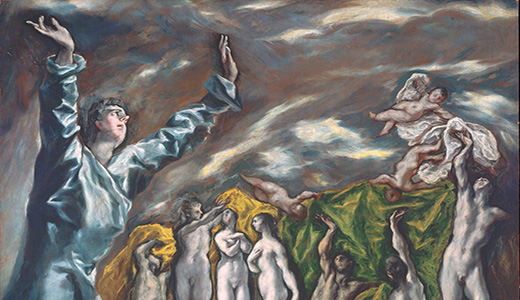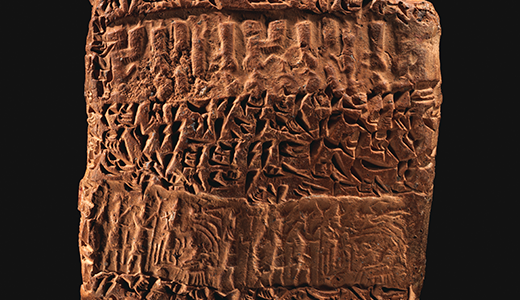 2018
2018
The Vision of Saint John, by El Greco, c. 1608. The Metropolitan Museum of Art, Rogers Fund, 1956.
The Doomsday Clock was set to two minutes until midnight on January 25, 2018, the closest it’s been to the apocalypse (aka midnight) since the height of the Cold War. Created in 1947 by the Manhattan Project atomic scientists responsible for building the world’s first nuclear bomb, the clock measures the countdown to humanity’s destruction. The scientists consider such factors as the proliferation of nuclear weapons, global warming, and international relations when determining where to set the clock each year. The dramatic lows of the present—North Korea’s growing nuclear capabilities, inaction on climate change, antagonism between the United States and other nations, the nefarious misuse of social media—left them rattled.
In their annual statement, the scientists wrote:
In 2017, world leaders failed to respond effectively to the looming threats of nuclear war and climate change, making the world security situation more dangerous than it was a year ago—and as dangerous as it has been since World War II.
The greatest risks last year arose in the nuclear realm. North Korea’s nuclear weapons program made remarkable progress in 2017, increasing risks to North Korea itself, other countries in the region, and the United States. Hyperbolic rhetoric and provocative actions by both sides have increased the possibility of nuclear war by accident or miscalculation.
On the climate change front, the danger may seem less immediate, but avoiding catastrophic temperature increases in the long run requires urgent attention now. Global carbon dioxide emissions have not yet shown the beginnings of the sustained decline toward zero that must occur if ever greater warming is to be avoided. The nations of the world will have to significantly decrease their greenhouse gas emissions to keep climate risks manageable, and so far, the global response has fallen far short of meeting this challenge.
Beyond the nuclear and climate domains, technological change is disrupting democracies around the world as states seek and exploit opportunities to use information technologies as weapons, among them internet-based deception campaigns aimed at undermining elections and popular confidence in institutions essential to free thought and global security.
 c.
2235 BC
c.
2235 BC
Cuneiform tablet, c. 2000 BC. The Metropolitan Museum of Art, Gift of Mr. and Mrs. J. J. Klejman, 1966.
The end of the world has been nigh for the last four thousand years. The earliest recorded lamenting over the apocalypse dates back to clay tablets from c. 2235 BC. The god-king Naram Sin of Akkadia, or ancient Mesopotamia, was bemoaning recent military defeats and invoking the all-powerful deity Enlil to destroy his foes. His story—part of the cultural tradition of apocryphal literature that has existed since c. 3000 BC—was transcribed in cuneiform and stored in the world’s first library in Nineveh. The remaining fragments of the “Cuthean Legend of Naram Sin” are now housed in the British Museum and museums in Turkey.
Naram Sin foresees the end of the world for his enemies:
Famine and misfortune of every kind came down upon them.
Above in the city there was a flood
In days to come Enlil will summon them for evil
They are waiting for the angry heart of Enlil
The city of those warriors will be massacred
Its dwellings will be burnt and besieged;
The city will pour out its blood
The earth will diminish its store, the date-palm its yield
The city of those warriors will die
City will fight with city, house with house,
Father with father, brother with brother,
Young man, with young man, friend with companion,
They will not speak the truth one with another.
The people will have been taught untruths and strange things.
The great gods have brought them to a reckoning